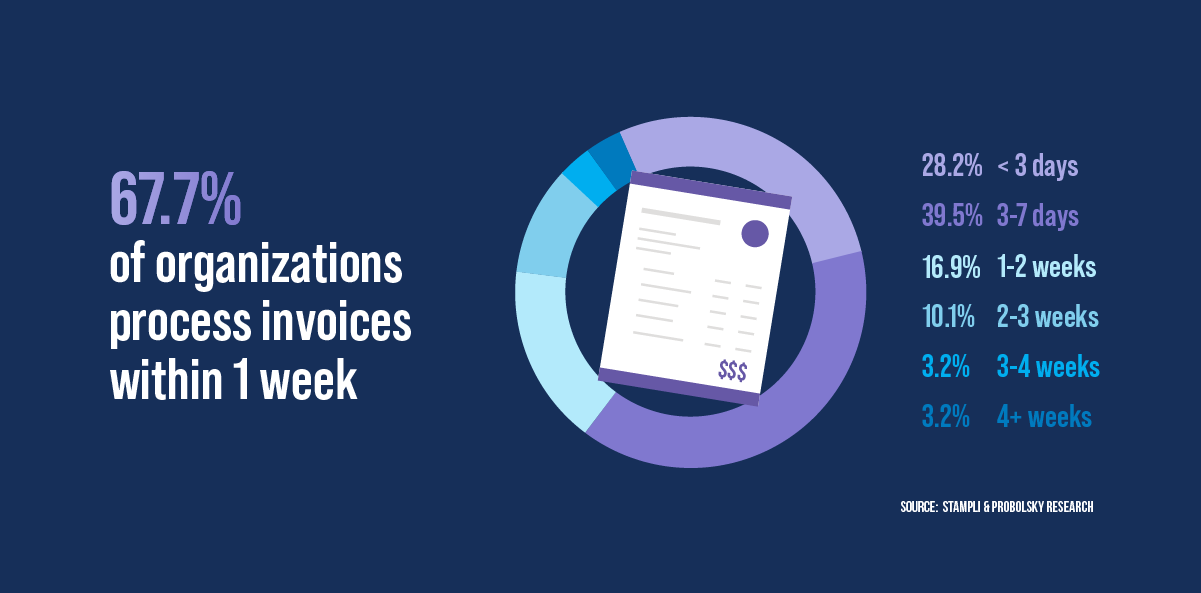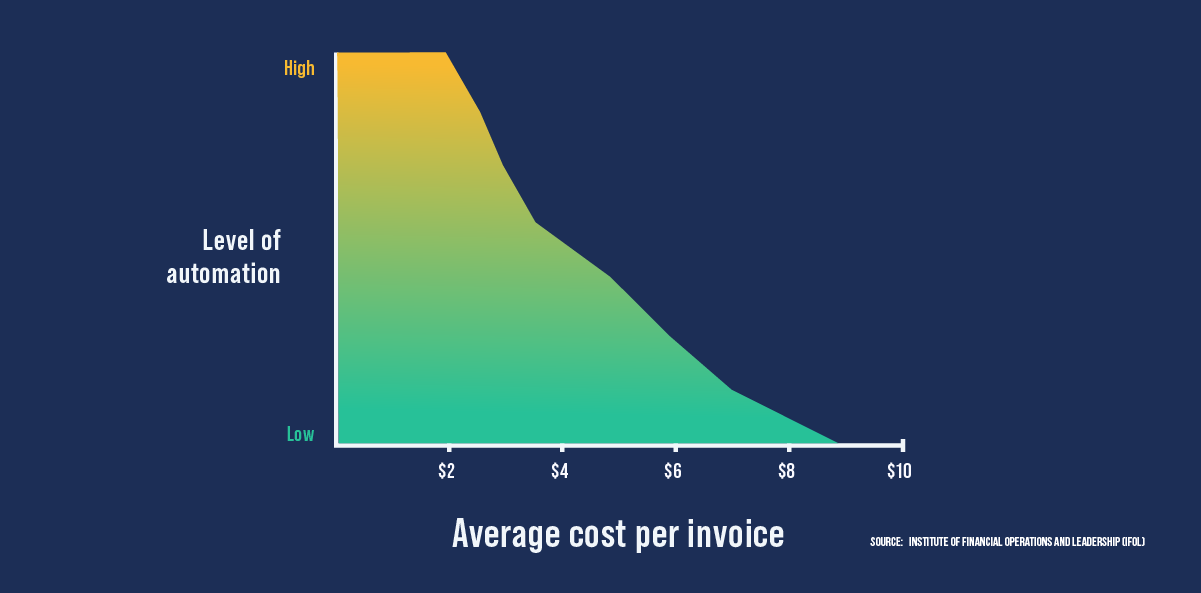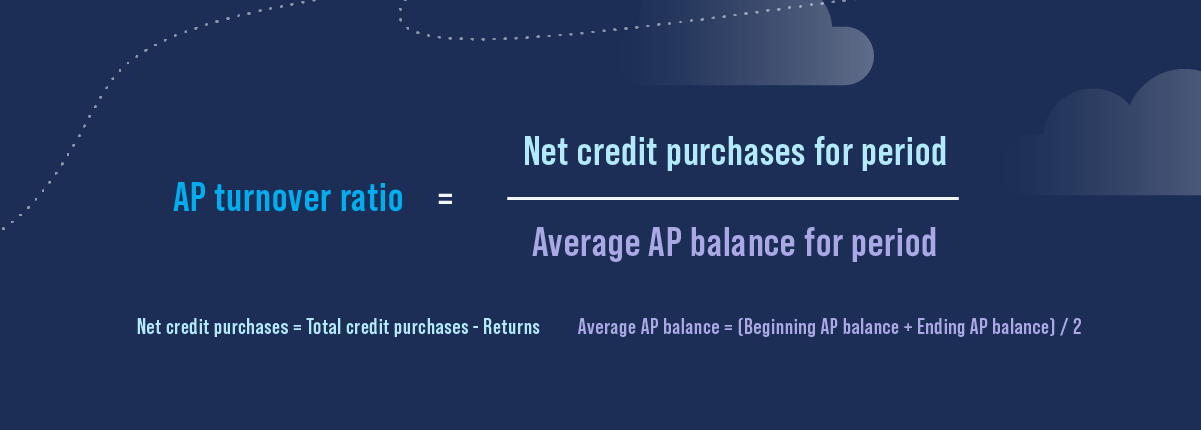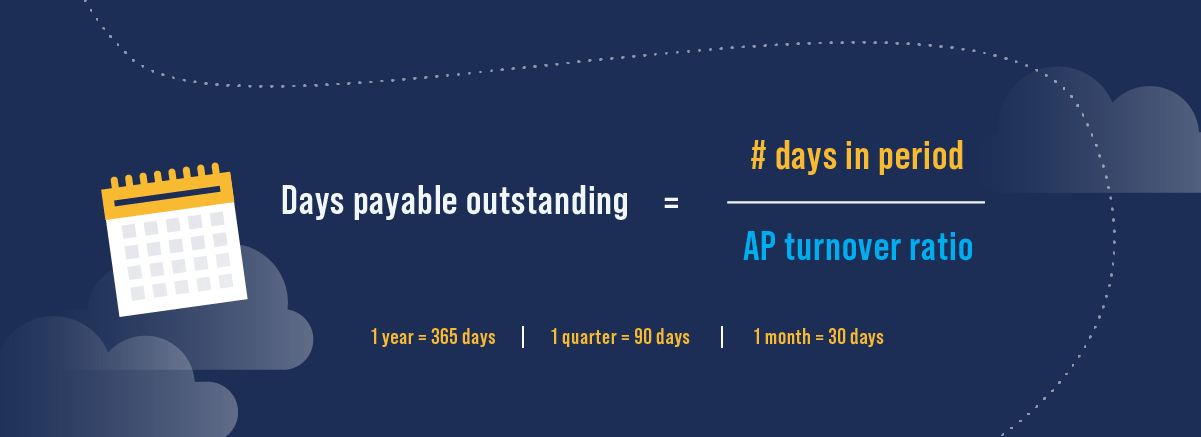Accounts payable benchmarking: How to grow AP performance

Am I doing this right?!
Whether in school, at work, or late at night pondering the meaning of life — all of us have asked ourselves this.
Which is what makes benchmarks so valuable.
Benchmarks are pivotal for accounts payable and leaders in other financial sectors to contextualize their performance.
Accounts payable benchmarking can unveil how you compare to others in your industry, to the wider norms, and perhaps most interestingly — to your own performance over a period of time.
Need help assessing whether or not your team’s performance is up to snuff, and how to boost your numbers if you’re looking to improve?
Come along as we help you zoom out of the trees and view the whole forest that is AP efficiency. We’ll explain the key benchmarks worth measuring, how to calculate them, what standards to track them against, and achievable tips to improve performance — including how to implement AP automation to grow key performance indicators (KPIs) across the entire finance function.
6 accounts payable performance benchmarks and tips for improving each
Because we have a lot to cover in this article, we’ll plunge right into benchmarks and best practices for measuring and growing overall AP efficiency.
But before we do, we want to highlight something that’s really cool about benchmarks: They don’t have to be external!
While we’ve tried to include some general standards where we could, you can also use internal benchmarks — numbers that are based on your own performance — to measure progress against each of these key accounts payable metrics.
Often, measuring internal changes can be much more telling than holding yourself accountable to standards that don’t fully apply to you. That’s why we love internal benchmarking.
Related, also keep the specifics of your business in mind when considering and calculating each KPI we’re about to cover. A “good” invoice processing time or AP turnover ratio can depend on a lot, including your industry, business size, and goals.
That said, we hope this robust primer starts you off on the right foot with using accounts payable benchmarking to enhance AP and finance team performance.
Invoice processing time
Invoice processing time accounts for each minute an accounts payable team spends working on an invoice from a vendor or supplier, from the time it’s received to the time it’s paid.
There are several steps in the invoice processing workflow, including:
- Receiving invoices
- Capturing and recording all the invoice data
- General ledger (GL) coding
- Matching and validating invoices using the purchase order and other relevant documentation
- Getting approval on the expenditure as needed
- Authorizing and submitting the invoice for payment
- Processing the invoice to schedule and make the actual payment
- Archiving the invoice and related information so it can be tracked and reported upon later
According to a study of AP professionals and senior-level finance managers Stampli conducted in conjunction with Probolsky Research, the majority of organizations are completing the bulk of this process — from capture through payment authorization — in 7 days or less.

Of course, it’s critical to process invoices as fast as possible, simply to make sure they’re out of your hair and paid at exactly the right time without racking up any late fees.
But there are plenty more reasons why speeding up invoice processing time can be beneficial:
- Understanding overall AP efficiency: Processing time is a great indicator of AP operations efficiency, and measuring it over time can help identify bottlenecks and motivate you to find opportunities for improving your systems.
- Better vendor relationships: You don’t have to be the fastest invoice processor in the world, but if you can be a reliable one that pays punctually and sets realistic expectations around processing time — you may become a favorite among your vendors and suppliers!
- Labor savings: Of course, the savvier you get with the payment process the less money you’re spending paying talented AP pros to focus on menial, manual tasks. Stay tuned to the next section for tips on getting savvy.
- Improved cash flow: Paying invoices, whether too late or even too early, has an impact on cash flow. When you have a smooth, predictable processing time, it’s much easier to accurately forecast and utilize company cash flow without any risk of going into the red. Bonus, you may even be able to take advantage of early/on-time payment benefits and add to the bottom line.
Tips to improve invoice processing time:
- For non-approved purchase order (non-PO) invoices, such as one-off expenses like reimbursements…
- Provide invoice approvers with easy ways to review and approve invoices, such as via mobile devices and email.
- For pre-approved purchase order (PO) invoices, where an invoice is generated after an order is approved and minimal processing time should be required, you may be able to boost timelines when you…
- Utilize reporting to identify and address deviations that should be avoidable during invoice matching.
- Provide buyers with easy ways to review and approve deviating invoice items, such as through email or even on mobile.
- Whether it’s PO or non-PO invoices you’re dealing with, prioritize a smart, integrable AP automation solution like Stampli to streamline key elements of invoice processing such as capture, routing, matching, coding, approvals, and follow-ups.
Invoices per FTE
Invoices processed per full-time equivalent (FTE) is a performance metric that helps you understand your team’s average output. In addition, it provides great insight into your AP staffing strategy and may uncover ways to lessen costs with just a few small tweaks.
The higher the number, the better. The more invoices an FTE is able to process in a certain time period, the more effective and efficient your team. This has a positive impact on the bottom line in more ways than one — growing cash flow, improving forecasting, and making the most of labor expenditure.
Finding invoices per FTE is simple, just divide the number of invoices processed in a certain amount of time by the number of FTEs during that same time period.

The American Productivity and Quality Center (APQC) found in an accounts payable benchmarking report that the average AP FTE processes 10,853 invoices in a year. Fully automated in AP? That number jumps considerably to 23,333 invoices annually. Processes nearly fully manual? It shrinks to just 6,082 invoices per FTE, per year.
Tips to improve invoices per FTE
An AP benchmarks survey from the Institute of Financial Operations and Leadership (IFOL) found a correlation between both centralization and automation and faster invoice processing — aka, growing your invoices per FTE number.
By their measure, “significant automation” (at least 70% of invoices processed electronically via a workflow automation program) and deep centralization (every AP function integrated and working in harmony with related operational departments) are both required to hit that >20K invoices per FTE number.
We already touched on how to painlessly inject AP automation into whatever system you’re using (Stampli easily integrates with every best-in-class ERP after all!). Once you’ve actioned that tip, here’s how to move forward with AP centralization and close invoices quickly:
- Build your data hub by plugging Stampli into your ERP and accounting systems to facilitate information exchange across business units. This boosts everyone’s speed and accuracy by ensuring all are working with the best data you have.
- Enforce internal controls in this centralized hub you’ve built to ensure all employees adhere to the same policies and are moving toward the same goals (such as faster, more accurate invoicing processes!).
- Automate invoice approval routing to either pay via your AP system or automatically send authorized invoices for payment via your ERP.
- With everything and everyone sharing centralized information and automation, you can more accurately view spending and improve cash flow forecasting.
Cost to process an invoice
It can be difficult to find exactly how much it costs your organization to complete an invoice.
After all, there are plenty of factors, hidden and otherwise, that impact this workflow:
- Labor costs
- Tooling expenditures
- Managing and storing paper invoices
- Fixing entry errors and duplications
- Fraud prevention and expenses
- Late fees
- Enforcing compliance regulations
The easiest way to get the most accurate and consistent approximation of your average cost per invoice is to cut out most of the noise and go for a few solid numbers you know well, like invoices processed and labor costs.
Thus, figuring out the cost of an invoice comes down to an easy formula. Just divide the number of invoices processed at any given time by the cost of the labor to process them during that time.

For AP labor costs, first find the salary of each person who primarily handles your invoice processing. Then ask them to approximate what percentage of their time in a year is spent on this task. Multiply these numbers to find labor cost per individual. This looks like: AP labor cost of individual = % of time processing invoices yearly x salary.
Finally, add up all your individual numbers to get your total AP labor cost to insert into the above equation.
(Note: If your AP process is not highly automated, chances are a lot of people across your business touch invoices, such as for approvals. If you want to get really technical you can even find their labor cost using the same process we just detailed.)
Compare this cost yearly, or even quarter-over-quarter, to measure improvement as you check off the tips below for boosting AP performance.
While the cost of processing an invoice can really vary widely, as we mentioned, the average cost of paying an invoice for a highly-automated company is around $3.40, and quite a bit more at $7.90 for a business with a low level of automation

Tips to improve the cost to process an invoice:
- Automate labor expenses: Automation is one of the best ways to cut down on human costs in AP, such as the cost of labor on repetitive menial tasks, correcting mistakes, making late payments, and making duplicate payments. With automation on board, your smart AP professionals get to focus on deep work that’s more rewarding.
- Work around the paperwork: Processing, maintaining, and simply storing AP paperwork requires a lot of work from employees. Working with paper takes time; it’s frustrating; it’s not trustworthy, and worst of all, it can be insecure. Digitize your AP systems to eliminate paper from your workflows.
- Outsource the regulatory and fraud legwork: Keeping up with compliance and preventing AP fraud is critically important to businesses, especially now with bad actors getting more tech savvy every day. What AP pros can’t, or maybe just don’t have the time to do, a modern AP solution can offer support.
Share of discounts captured
Here’s an interesting way to understand AP team performance: Look at how much actual cold, hard cash they’re able to save.
In AP, that means taking advantage of vendor or supplier discounts for early, or even just on-time payments.
The share of discounts captured benchmark compares the number of early payment discounts your AP department secures, compared to those offered. When you measure this, you’ll be better prepared to track missed opportunities and the potential savings you could have achieved through early payments. Once this is uncovered, you can start looking for reasons for missed discounts, such as insufficient staffing and poor technology.
To find share of discounts captured, divide how many discounts you were able to take advantage of by the total number available — all during the same time period.

IFOL found that, again, businesses with a high level of centralization and automation were able to capture between 85% and 95% of discounts. That’s incredible compared to the average among all AP departments, which was around 58%.
Tips to improve share of discounts captured:
- Bring together procurement and AP: AP can help procurement shop for suppliers with better discounting, while procurement can work more closely with AP to ensure they’re aware of available discounts so they can prioritize correctly.
- Streamline incoming invoices: Work with suppliers and anyone on your team who may receive invoices to create a process that gets all invoice information to AP quickly, before discounts dry up.
- Speed up approvals: With modern AP software, automated invoice approval routes can be configured to instantly determine the path an invoice must take to verification and approval — fast and with little human input.
- Report on discounts: Make sure your AP software is able to track discounts in its various AP reports. By keeping an eye on discounts available vs. discounts taken, you can continue to improve this benchmark and improve savings and staffing.
AP turnover ratio
The accounts payable turnover ratio is one of several helpful ratios for understanding and growing AP performance. It clarifies how fast you’re able to pay off the suppliers and/or vendors who invoice you. In this way, it provides insight into several things — the efficiency of your AP department (and ability to grab early payment deals!), your near-term liquidity as a company, and even the health of your overall reinvestment strategy.
Allow us to explain.
A decreasing AP turnover ratio typically points to one thing: You’re taking longer to pay off debts. Of course, this can just happen from time to time if your suppliers and/or your agreements with them change. But it could also mean you’re struggling to generate the liquidity you need to pay off short-term debts. Keep an eye on this.
An increasing AP turnover ratio shows that you’re paying off suppliers more quickly. This is generally a good thing, as it means you have the liquid cash as well as the efficiency to manage debts in a healthy time frame. But be warned, a super high (or consistently increasing) turnover ratio may indicate you’re spending all your cash instead of reinvesting it back into opportunities for longer-term business growth and earning.
Sounds like there’s a sweet spot you should be aiming for, right?
Good eye.
A ratio that falls between six and 10 is thought to be a good goal at the time of this writing.
And how exactly do you find your ratio?
The AP turnover ratio divides net credit purchases for a period by the average accounts payable balance for that period.
In this instance, net credit purchases equals total credit purchases, minus returns. The average AP balance is your beginning AP balance + ending AP balance, divided by two.

Tips to improve AP turnover ratio:
- Negotiate preferable terms: Sometimes, timing just isn’t on your side to adjust AP turnover ratio in your favor. Once you have a good relationship with a vendor, see if you can secure payment terms that are better suited to your situation.
- Monitor AP aging: Keep an eye on accounts payable aging to ensure you’re consistently making payments aligned with your AP turnover ratio.
- Deploy electronic payments: Use electronic payments to quickly pay and also schedule supplier payments and improve your AP turnover ratio.
- Simplify with automation: An automated AP automation program that wraps everything up with a bow — from invoice reception and capturing to matching, approving, routing, paying, and storing — means quicker payments, fewer mistakes, and more security and compliance. Improving both your timelines and supplier relationships in this way can help boost your AP turnover ratio.
Days payable outstanding
A lot of businesses like to take the above benchmark even further to fully understand how many days, on average, it takes to wrap up an invoice in any given period of time (such as a financial quarter). This number is called days payable outstanding (DPO), or accounts payable days.
While it certainly sounds complex, you can actually find this number relatively easily once you know your AP turnover ratio. You just divide the number of days in a certain period by the AP turnover ratio for that period.

The result is the number of days it took to pay an invoice.
Similar to AP turnover ratio, a higher number of days means it’s taking you longer to pay invoices. That’s not necessarily a bad thing, since it could mean you’re keeping cash on hand for upcoming investments. This is especially true in the case of startups or other organizations pursuing growth.
But if that isn’t part of your strategy, a DPO that’s slipping longer and longer may indicate cash flow troubles, AP inefficiencies, or all of the above. That’s what makes benchmarking this number critical to examining and boosting AP performance.
A reminder before we move into the tips: DPO, as well as AP turnover ratio, depend on several factors. Your industry is one. For example, a retail company will probably have naturally high AP turnover and low DPO numbers. Larger companies, as well as companies that negotiate longer payment terms, will have higher DPO and lower AP turnover ratios.
Tips to improve DPO:
- Align payment terms: Balance your payment terms with those of your suppliers to avoid stretching out your DPO due to misalignment. For instance, if your payment terms are 90 days but your suppliers’ terms are 60 days, adjust accordingly to bring DPO down.
- Define AP team duties: Increase efficiency by effectively planning payment runs and clearly assigning duties with set deadlines across your AP team. This reduces redundancy and enhances accountability and efficiency.
- Optimize invoice management: Streamlining invoice management with purpose-built software saves time and offers additional benefits like:
- automating smart accounts payable processes to bust errors and manual tasks
- creating a collaboration hub to unify invoice comms
- building a management dashboard to increase visibility and reporting
- segregating duties to enhance ownership and security.
Boost & measure accounts payable performance with Stampli AP automation
There should be no surprise at this point that automation is central to both understanding and boosting your accounts payable benchmarks.
Per Probolsky Research, as many as 80% of accounts payable teams have some automated or digital elements. But only 18% are fully automated.
What’s the holdup?
Aside from cost, fear around staff knowledge, data security, and ERP integration were among the top barriers to adopting AP automation.
We didn’t build the Stampli financial automation platform to be first in AI and adaptability for nothin’.
Stampli can be personalized to function within the ERP configuration you’re already working on within weeks, not months. We know how important it is to be able to quickly and easily bring all things AP under one roof to maximize your control and speed while reducing manual workarounds and blindspots.
Part of this flexibility is thanks to Billy the Bot™, our AI that can learn your processes to automate key elements and free up your valued AP employees to focus on value-adding tasks.
So, if you’re also worried about ERP disruption and spending months bringing your entire team up to speed, Stampli’s easy-to-learn and quick-to-adapt system can take those concerns off your plate.
Now, how about data safety?
Aside from our compliance with leading compliance and security regulations, moving your AP processes into Stampli eliminates insecure paperwork and also enables you to enforce segregation of duties (SOD) controls. These help prevent fraud and data handling errors by increasing responsibility and transparency in data management.
We hope we’ve shown you how Stampli is devoted to helping accounts payable departments modernize their workflows by automating secure, easy-to-use, and easy-to-install invoice management.
Ready to invest in automation so you can finally track and sustainably improve your most important accounts payable benchmarks? Schedule a demo with a Stampli AP Hero right now.